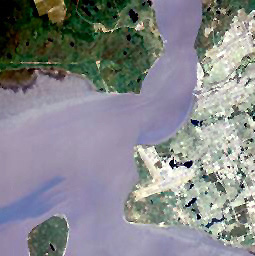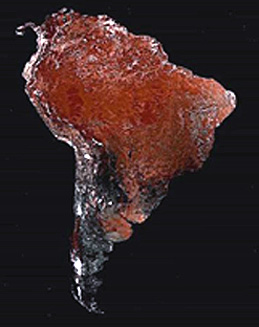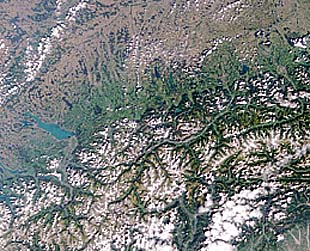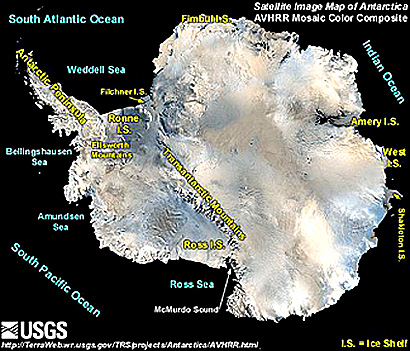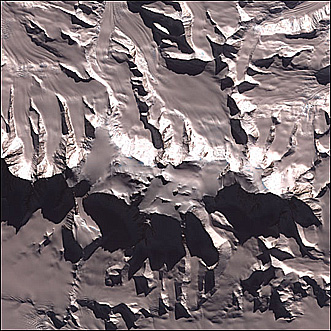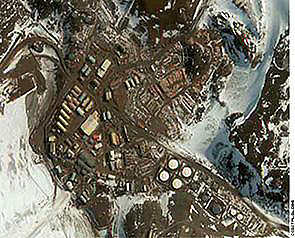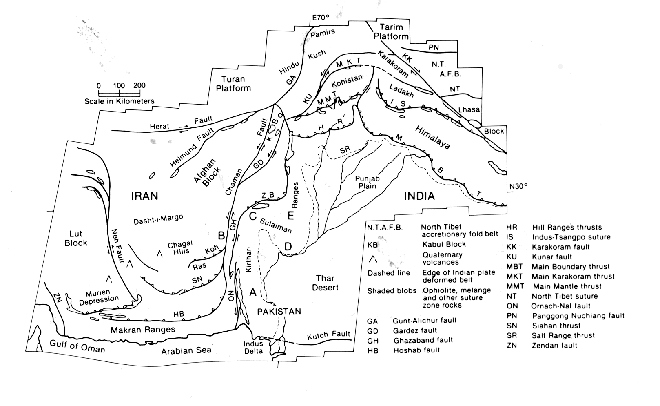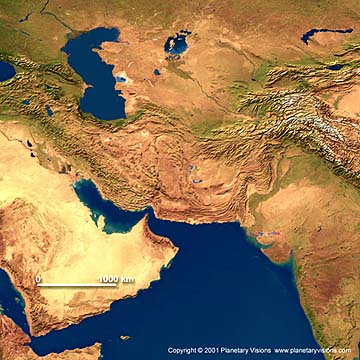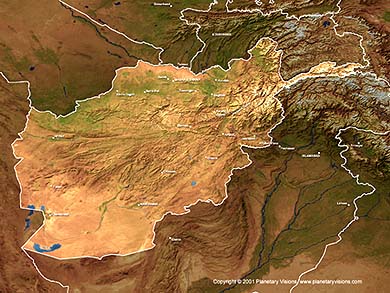MSS Mosaics of the United States; Alaska; Mexico; International Mosaics and large scenes including Afghanistan¶
Contents
Additional mosaics of the U.S., Alaska, and regions in Europe and Asia demonstrate the value of combining space images to present views of large segments of the Earth�s continental surfaces. A series of images shows Afghanistan and its neighbors - the focus of attention in the first year of the War on Terrorism.
MSS Mosaics of the United States; Alaska; Mexico; International Mosaics and large scenes including Afghanistan¶
The General Electric Company produced the first false color rendition for NASA and the National Geographic Society (NGS). We reproduce here a portion of the NGS Magazine’s Landsat “map” of the U.S., which was part of its Bicentennial (1976) anniversary issue, in the natural color version.
|A quasi-natural color mosaic of the entire western half of the United States, from Canada to Mexico and from the Great Plains to the Pacific coast; made for the National Geographic Society by General Electric Space Division using Landsat imagery. |
In making this mosaic (there is also a false color red version), GE projected the MSS Band 7 through a green filter and Bands 4 and 5 through blue and red filters). It shows all of the western U.S. into the Great Plains beyond Denver and the Black Hills. Blackish areas on land are either water bodies (such as the Great Salt Lake) or vegetated mountain slopes. Obviously, relatively little detail in the landscape is visible at this scale (~1:11,000,000) but the impression of the overall geomorphology and geologic structures that set the western U.S. apart is striking (more so when the full size - 14 ft wide - is viewed. Compare this rendition with the equivalent area in the NOAA Advanced Very High Resolution Radiometer image presented on page 6-1.
` <>`__7-8: While this is a passably good natural color approximation, something does not ring true. Why; what’s missing?`ANSWER <Sect7_answers.html#7-8>`__
Alaska Mosaic
The first Landsat mosaic to cover the United States was made, following a suggestion by this writer (NMS) and then under the aegis of a colleague, Arthur Anderson, by the Soil Conservation Service. After it was made, someone realized that the states of Hawaii and Alaska had been overlooked. An effort to correct this soon produced the missing states. Hawaii was easy. The Alaska mosaic was more problematic as at the time there was a missing strip of coverage and the western Aleutians were also not covered. Still, the mosaic shown here is imposing; a map of its main features is placed below it:
Notice on the map a number of symbols, e.g., OS. These refer to the generalized locations of different structural terranes - great blocks of crust that at different times in the distant past crashed into that part of the North American plate (both before and after its split from Pangaea) and thus built up the region by accretion. The concept of terranes is discussed in much more detail in Section 17 (second half). For now, we will just identify these terranes by name: Agm = Angayucham; Ch = Chugach; End = Endicott; Kyk = Koyukuk; NxF = Nixon Fort; OS = Overlap Sequence; Pn = Peninsular; Por = Porcupine; PW = Prince William; Sew = Seward; Tog = Togiak; Toz = Tozina; Wr = Warngellia; YT = Yukon/Tinana; Yuk = Yukon. Major faults are numbered.
It is interesting to compare this Landsat mosaic with a single image produced in color by the MODIS sensor on Terra (Section 16). The image covers about 2/3rds of the main part of the state. Try to locate some of the features and terranes listed above in this image:
` <>`__7-9: Why does the MODIS image appear so different from the Landsat mosaic?`ANSWER <Sect7_answers.html#7-9>`__
Lets look at the Alaska Range closer up using this Landsat 5 image. Mt. Denali at 6160 m (20320 ft) is the highest point in North America. This mountain is treacherous to climb because of sudden, fierce storms; many lives have been lost in the attempt.
One of the big three cities in Alaska is Anchorage (the others: Juneau [the capital] and Fairbanks). Locate it in the map above. Here is a SIR-C view:
Mosaic of Mexico
A standard false color mosaic of Mexico, extending into parts of the southern United States, appears thusly:
South America
Mosaics have now been produced for entire continents. North America has been constructed from Landsat images, and several images of the United States appear in this Tutorial. Using AVHRR data (see page 14-2), all of South America has been mosaicked; the Andes and the Amazon in particular stand out:
` <>`__7-10: Can you pick out the general regions in this mosaic that correspond to the Amazon rain forest; how did you do this?`ANSWER <Sect7_answers.html#7-10>`__
Color Mosaic of Southern Europe: The Alps
Another magnificent mosaic, made as a variant of true color, shows the entire Alps (Alpine Mountain Chain) across southern Europe, including all of Switzerland and Austria, and parts of eastern France, southern Germany, Czechoslovakia, Slovenia, Croatia, and northern Italy. Westermann Satellite Maps prepared this mosaic, which, shortly after its production, became a standard aid for teaching geography to students in many European countries.
Below is a schematic map that shows most of the same area as in the Alps mosaic; this map defines the geologic/geomorphic segments of the Alps as well as for adjacent terrains. Try to match the main units to their topographic expression in the mosaic.
` <>`__7-11: Locate the Apennines on the mosaic, using the map. Develop a single item argument that supports this statement: The Apennines are not nearly as high as the Alps?`ANSWER <Sect7_answers.html#7-11>`__
While we are focussed on the Alps, compare this next scene, made by the MISR sensor on Terra, of a part of the Alps (fit it in to the above mosaic).
The Antarctic and the Arctic¶
The entire Antarctic continent and surrounding ice shelves has been imaged from sets of radar images acquired over six days in September of 1996 by the NASA Scatterometer (NSCAT), as shown below, with the South Pole appearing as a drawn-in black dot:
This whole continent, about the size of the U.S. and Canada combined, has been imaged in color by specially processing AVHRR scenes acquired by meteorological satellites. This mosaicked version, produced by Pat Chavez’s image processiong group at the U.S. Geological Survey, is shown here in its annotated form:
It is a bit of a surprise to those (most of us) who know little by the Arnarctic continent to learn that it has high mountains. The high point of the continent, the Vinson massif, at 4897 m (16067 ft) in the Ellesmere Range has been climbed. Here it is in an ASTER image.
Turning to the other extreme, here is a very high resolution (2.4 m) of the U.S. Antarctic Research Base at McMurdo Sound (bottom center of the above mosaic) as imaged by the QuickBird satellite (see Overview):
The MODIS instrument on Terra (page 16-9) has obtained a view of the North Pole (in the image below the longitudinal lines converging at it are added artificially), even though it does not pass directly over it (in the image below it has looked slightly sidewards). The polar Arctic is not a land mass but a sea covered with ice. While the scene roughly resembles the ice sheet covering central Antarctica, the give-away that the Arctic has sea ice is the sets of leads (fractures) that result from ice cover breakup and movement.
Mosaics of Iran, Pakistan, India, and Afghanistan
The region displayed in this black and white, red band mosaic includes nearly all of Pakistan, part of eastern Iran and a bit of southern Afghanistan, and a smaller segment of India, extending over about 2,100 km (1,305 mi) from west to east. We drew the principal structural features on the locator map below.
The continuous mountain belt starting with the east-west Makran Ranges, then the north-trending Kirthar and Sulaiman Ranges in Pakistan, and the great bend of the Hindu Kush joining the north-west-trending western Himalayas, is the consequence of the monstrous, still continuing, collision of the Indian subcontinent during the last 130 million years as it drifted north, striking the underbelly of Asia along a vast subduction zone.
` <>`__7-12: This question is a departure into the realm of ancient history in which the Landsat mosaic helps to show what the problems were in the events that led to the demise of the Macedonian Alexander the Great. Maybe you know the story; if not, consult an encyclopedia for a synopsis of his life. What was the situation he faced, and how did the imagery help you to appreciate its gravity?`ANSWER <Sect7_answers.html#7-12>`__
The region just to the north of the top center of this mosaic has became famous - and infamous - to Americans since September 11, 2001. The country of Afghanistan is in many ways similar to Pakistan, with desert, a group of central mountains, and mountains on its southeast border with Pakistan. Afghanistan lies within this 4 km resolution metsat AVHRR image of the broad region that includes Saudi Arabia, Iran, Pakistan, Afghanistan, and the several “Stans” such as Turkestan - once countries once part of the Soviet Union
This next view zeroes in on the region that includes all of Afghanistan.
In this image, the outlines of the country are added, while the processing has reduced the emphasis on mountain terrain.
` <>`__7-13: In the above image, try to find the area encompassing the Afghanistan-Pakistan border where Osama bin Laden and his Al-Queda terrorists are believed to be hiding out as of December 2002.`ANSWER <Sect7_answers.html#7-13>`__
That mountain terrain is strongly depicted in this reprocessed image:
Just to its northeast is this Landsat subimage that includes Kabul and several of the Afghan towns much in the news since the War on Terrorism:
The ability to produce mosaics from high resolution imagery such as Landsat opens a new dimension in the study of Earth’s land masses at continental and regional scales.
Computer displays lose much of the detail from this resolution, but when we prepare a large space photomosaic, either at the scale (1:1,000,000), at which it is normally printed or at a moderately reduced scale (say, 1:2,500,000) to keep it’s size manageable, we retain most of the original information. The chief users of mosaics, such as those shown above, are geographers, structural geologists, and geomorphologists, all of whom benefit from the panoramic vista afforded by seeing local features in a regional context.
These mosaics also dovetail nicely with the lower resolution views of continents at the hemispherical scale provided by meteorological satellites, such as Nimbus (see page 14-4) and GOES (see page 14-7).


